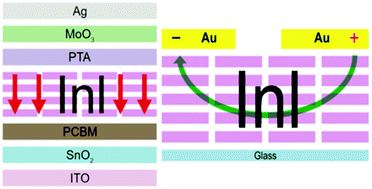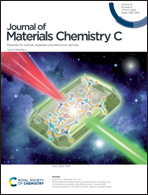Experimental evaluation of indium(i) iodide as a lead-free perovskite-inspired material for photovoltaic applications†
Abstract
The recent discovery of the photovoltaic (PV) effect in indium(I) iodide thin films has attracted considerable attention, as this material can be a feasible environment-friendly alternative to the conventional lead halide perovskites. Previously published computational and spectroscopy data suggested that In I could deliver photovoltaic performances comparable to complex lead iodides; this prediction, however, was not supported by a recent experimental study. To address this contradiction, herein we evaluated systematically the potential of In I as a semiconductor material for photovoltaic applications. The solar cells assembled with In I as a light absorber material demonstrated modest power conversion efficiency of 1%. However, the lateral two-terminal devices showed a rather outstanding photoconductivity effect, which we utilized to fabricate photodetectors demonstrating a competitive performance: photodetectivity approaching 1.4 × 103, specific detectivity of 5.0 × 1011 Jones, and maximum pulse frequency of 93.6 kHz. Similar devices assembled in the vertical geometry delivered much inferior performance. GIWAXS analysis revealed that In I films are strongly textured and grow with the crystallographic b-axis oriented perpendicular to the substrate, which means that the layers composed of interconnected In and I atoms are lying parallel to the substrate. The estimated effective charge carrier lifetimes in lateral and vertical devices (2 ms and 15 ms, respectively) confirmed that their strikingly different performances are due to the structural and electronic anisotropy of In I films. The obtained results reveal the importance of the structural dimensionality of the newly designed semiconductor materials: truly 3D structures are required to match complex lead halides in terms of their optoelectronic properties. On the contrary, materials with lower dimensionality, such as 2D In I, could provide excellent performance in lateral photodetector devices, whereas their efficient use in vertical geometry cells would require changing the preferential film growth direction, which is a solvable but a very nontrivial task.



 Please wait while we load your content...
Please wait while we load your content...